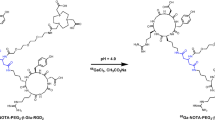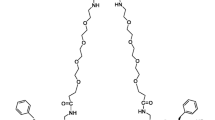Abstract
Purpose
EMD 121974, a potent cyclic RGD peptide inhibitor of α v-integrins, demonstrated effectiveness in suppressing brain tumor growth in both preclinical models and phases I/II clinical trials. The ability to non-invasively evaluate α v-integrin expression provides a novel and unique way to better understand brain tumor angiogenesis in relationship to α v-integrin expression, and allow for direct assessment of anti-integrin treatment efficacy.
Procedures
We developed a F-18-labeled RGD peptide [F-18]FB-RGD and performed serial microPET imaging scans to follow brain tumor growth and angiogenesis as a function of time in an orthotopic U87MG glioblastoma xenograft model in athymic nude mice.
Results
The tumor was barely visible on microPET at the size of ≤1.5 mm diameter at which time no angiogenesis was evident on histological examination. When tumor started to grow exponentially by day 35 the activity accumulation in the brain tumor also increased accordingly, with best tumor-to-brain contrast seven weeks after inoculation of 105 U87MG cells into the mice forebrain.
Conclusions
Longitudinal microPET imaging and [F-18]FB-RGD provides the sensitivity and resolution to visualize and quantify anatomical variations during brain tumor growth and angiogenesis, most likely through interaction with α v-integrins expressed on tumor cells and angiogenic tumor vessels.





Similar content being viewed by others
References
Jemal A, Tiwari RC, Murray T, et al. (2004) Cancer statistics, 2004. CA Cancer J Clin 54:8–29
Boiardi A, Silvani A, Pozzi A, et al. (1997) Advantage of treating anaplastic gliomas with aggressive protocol combining chemotherapy and radiotherapy. J Neuro-Oncol 34:179–185
Puduvalli VK, Yung AW (1998) New frontiers in therapy of malignant gliomas. Forum 8:261–269
Puduvalli VK, Sawaya R (2000) Antiangiogenesis—therapeutic strategies and clinical implications for brain tumors. J Neuro-Oncol 50:189–200
Taga T, Suzuki A, Gonzalez-Gomez I, et al. (2002) Alpha(v)-Integrin antagonist EMD 121974 induces apoptosis in brain tumor cells growing on vitronectin and tenascin. Int J Cancer 98:690–697
MacDonald TJ, Taga T, Shimada H, et al. (2001) Preferential susceptibility of brain tumors to the antiangiogenic effects of an alpha-v integrin antagonist. Neurosurgery 48:151–157
Cristofanilli M, Charnsangavej C, Hortobagyi GN (2002) Angiogenesis modulation in cancer research: Novel clinical approaches. Nat Rev Drug Discov 1:415–426
Anderson SA, Rader RK, Westlin WF, et al. (2000) Magnetic resonance contrast enhancement of neovasculature with α v β 3-targeted nanoparticles. Magn Reson Med 44:433–439
Sipkins DA, Cheresh DA, Kazemi MR, Nevin LM, Bednarski MD, Li KC (1998) Detection of tumor angiogenesis in vivo by α v β 3-targeted magnetic resonance imaging. Nat Med 4:623–626
Chen X, Park R, Shahinian AH, Bading JR, Conti PS (2004) Pharmacokinetics and tumor retention of 125I-labeled RGD peptide are improved by PEGylation. Nucl Med Biol 31:11–19
Chen X, Park R, Shahinian AH, et al. (2004) 18F-labeled RGD peptide: Initial evaluation for imaging brain tumor angiogenesis. Nucl Med Biol 31:179–189
Chen X, Park R, Tohme M, Shahinian AH, Bading JR, Conti PS (2004) MicroPET and autoradiographic imaging of breast cancer α v-integrin expression using 18F- and 64Cu-labeled RGD peptide. Bioconjug Chem 15:41–49
Chen X, Park R, Hou Y, et al. (2004) MicroPET imaging of brain tumor angiogenesis with 18F-labeled PEGylated RGD peptide. Eur J Nucl Med Mol Imaging 31:1081–1089
Chen X, Tohme M, Park R, Hou Y, Bading JR, Conti PS (2004) MicroPET imaging of α v β 3 integrin expression with 18F-labeled dimeric RGD peptide. Mol Imaging 3:96–104
Chen X, Hou Y, Tohme M, et al. (2004) PEGylated RGD peptide: 64Cu-labeleing and PET imaging of brain tumor integrin α v β 3 expression. J Nucl Med 45:1776–1783
Chen X, Liu S, Hou Y, et al. (2004) MicroPET imaging of breast cancer α v-integrin expression with 64Cu-labeled dimeric RGD Peptides. Mol Imaging Biol 6:350–359
Hauber R, Kuhnast B, Mang C, et al. (2004) [18F]Galacto-RGD: Synthesis, radiolabeling, metabolic stability, and radiation dose estimates. Bioconjug Chem 15:61–69
Haubner R, Wester HJ, Weber WA, et al. (2001) Noninvasive imaging of α v β 3 integrin expression using 18F-labeled RGD-containing glycopeptide and positron emission tomography. Cancer Res 61:1781–1785
Haubner R, Wester HJ, Burkhart F, et al. (2001) Glycosylated RGD-containing peptides: Tracer for tumor targeting and angiogenesis imaging with improved biokinetics. J Nucl Med 42:326–336
Haubner R, Wester HJ, Reuning U, et al. (1999) Radiolabeled α v β 3 integrin antagonists: a new class of tracers for tumor targeting. J Nucl Med 40:1061–1071
Janssen M, Oyen WJ, Massuger LF, et al. (2002) Comparison of a monomeric and dimeric radiolabeled RGD-peptide for tumor targeting. Cancer Biother Radiopharm 17:641–646
Janssen ML, Oyen WJ, Dijkgraaf I, et al. (2002) Tumor targeting with radiolabeled α v β 3 integrin binding peptides in a nude mouse model. Cancer Res 62:6146–6151
Van Hagen PM, Breeman WA, Bernard HF, et al. (2000) Evaluation of a radiolabeled cyclic DTPA-RGD analogue for tumor imaging and radionuclide therapy. Int J Cancer 90:186–198
Ellegala DB, Leong-Poi H, Carpenter JE, et al. (2003) Imaging tumor angiogenesis with contrast ultrasound and microbubbles targeted to α v β 3. Circulation 108:336–341
Greenberg HS, Chandler WF, Sandler HM (1999) Brain Tumors (Contemporary Neurology Series, 54). New York: Oxford University Press.
Spence AM, Muzi M, Krohn KA (2002) Molecular imaging of regional brain tumor biology. J Cell Biochem 39(Suppl):25–35
Blouw B, Song H, Tihan T (2003) The hypoxic response of tumors is dependent on their microenvironment. Cancer Cell 4:133–146
Holash J, Maisonpierre PC, Compton D, et al. (1999) Vessel cooption, regression, and growth in tumors mediated by angiopoietins and VEGF. Science 284:1994–1998
Zagzag D, Amirnovin R, Greco MA, et al. (2000) Vascular apoptosis and involution in gliomas precede neovascularization: A novel concept for glioma growth and angiogenesis. Lab Invest 80:837–849
Bergers G, Benjamin LE (2003) Tumorigenesis and the angiogenic switch. Nat Rev Cancer 3:401–410
Brooks PC, Clark RA, Cheresh DA (1994) Requirement of vascular integrin α v β 3 for angiogenesis. Science 264:569–571
Balaban RS, Hampshire VA (2001) Challenges in small animal noninvasive imaging. ILAR J 42:248–262
Toyama H, Ichise M, Liow JS, et al. (2004) Evaluation of anesthesia effects on [18F]FDG uptake in mouse brain and heart using small animal PET. Nucl Med Biol 31:251–256
Acknowledgments
The USC cyclotron team, particularly Joseph Cook and Luis Pedroza are acknowledged for routine [F-18]F− production. This work was supported, in part, by National Institute of Biomedical Imaging and Bioengineering (NIBIB) Grant R21 EB001785, Department of Defense (DOD) Breast Cancer Research Program (BCRP) Concept Award DAMD17-03-1-0752, DOD BCRP IDEA Award W81XWH-04-1-0697, DOD Prostate Cancer Research Program (PCRP) New Investigator Award (NIA) DAMD1717-03-1-0143, American Lung Association California (ALAC), the Society of Nuclear Medicine Education and Research Foundation, National Cancer Institute (NCI) Small Animal Imaging Resource Program (SAIRP) grant R24 CA93862, and NCI in vivo Cellular Molecular Imaging Center (ICMIC) grant P50 CA114747.
Author information
Authors and Affiliations
Corresponding author
Rights and permissions
About this article
Cite this article
Chen, X., Park, R., Khankaldyyan, V. et al. Longitudinal MicroPET Imaging of Brain Tumor Growth with F-18-labeled RGD Peptide. Mol Imaging Biol 8, 9–15 (2006). https://doi.org/10.1007/s11307-005-0024-1
Published:
Issue Date:
DOI: https://doi.org/10.1007/s11307-005-0024-1




